Frozen and Ambiguous Advice
Part 3 of the series How to be yourself, with help from Disney/Pixar (Thinking about Identity and the Inner Voice)
Flo married young. She and her husband, Moe, have three elementary-school-aged kids, two stable jobs, and one lackluster marriage. Moe is a decent guy, but he is also conventional and boring. Flo, by contrast, loves adventure and excitement. Moe is the moss, and Flo is a stone yearning to roll. She feels like the marriage is holding her back and wishes she could be with someone adventurous. When it comes down to it, she feels that as long as she is married to Moe, she is not being who she really is.
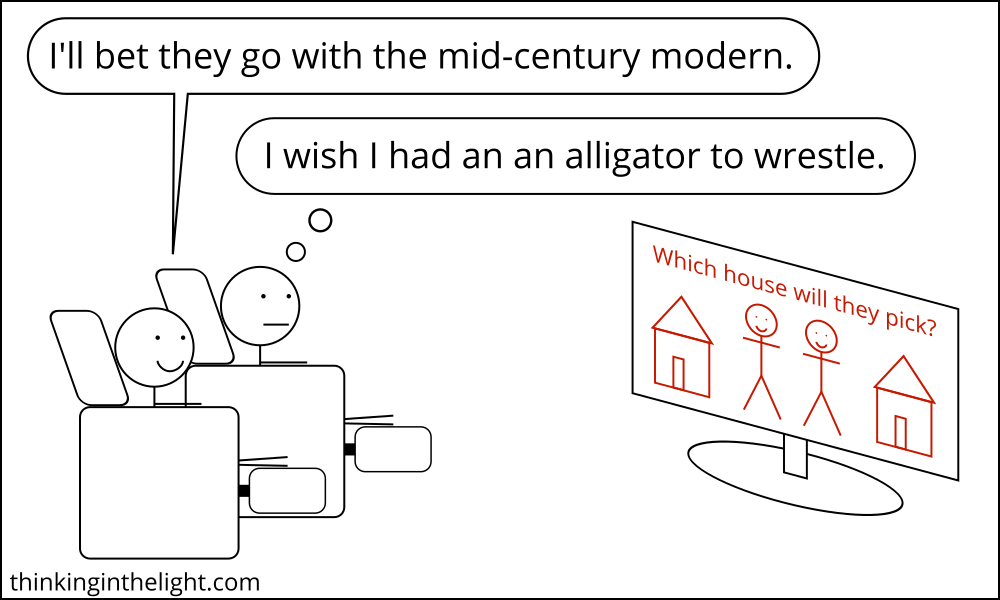
There are at least two ways to look at this situation, two different manners of thinking about the relationships between identity, morality, and the inner voice.
On the one hand, we could see Flo’s inner voice as being in conflict with her identity and what is right. Her feelings or internal sense are saying she should have a different life, but there are external relationships defining and obligating her to stay in this one: Moe would be devastated if she left the marriage, and the kids would suffer the emotional and logistical turmoil of having divorced parents. By leaving, Flo would be harming others. Since this is the case, she should stay despite how she feels. She is a wife and a mother, so she should try to adjust how she feels to match her situation.
On the other hand, we could see Flo’s inner voice as telling her what is right and defining her identity. Her feelings or internal sense show what she should do, and it would be wrong to do otherwise. If she stayed in a stifling marriage she would be harming herself. Additionally, she would be harming Moe by being inauthentic in their relationship, and she would harm her kids by not showing how to live fearlessly as one’s true self. She is an adventurous person, so she should adjust her situation to match her feelings.
What should Flo do? Is it “Moe goes slo-mo, so go grow, Flo!” or “Oh no, Flo! Show Moe no woe!”? Contemporary American culture will give both recommendations, and while some subcultures will lean one way or the other, the message can simultaneously contain elements of both. The culture often gives ambiguous advice when it comes to defining ourselves and the question of whether I should listen to my inner voice or instead turn to something outside myself.
This advice is unclear due to the way that it stems from potentially conflicting impulses. One leads us to focus outwards: we don’t want to harm others and we like narratives about answering the call to serve. (Sauron and self-serving politicians are bad; Frodo and first responders are good.) That is, we like people who are just and are heroes. But at the same time we often most glorify the turn inwards. We like people who are themselves. And despite the fact that there is a possible tension between these two positions, we don’t always acknowledge this or clarify how they relate.
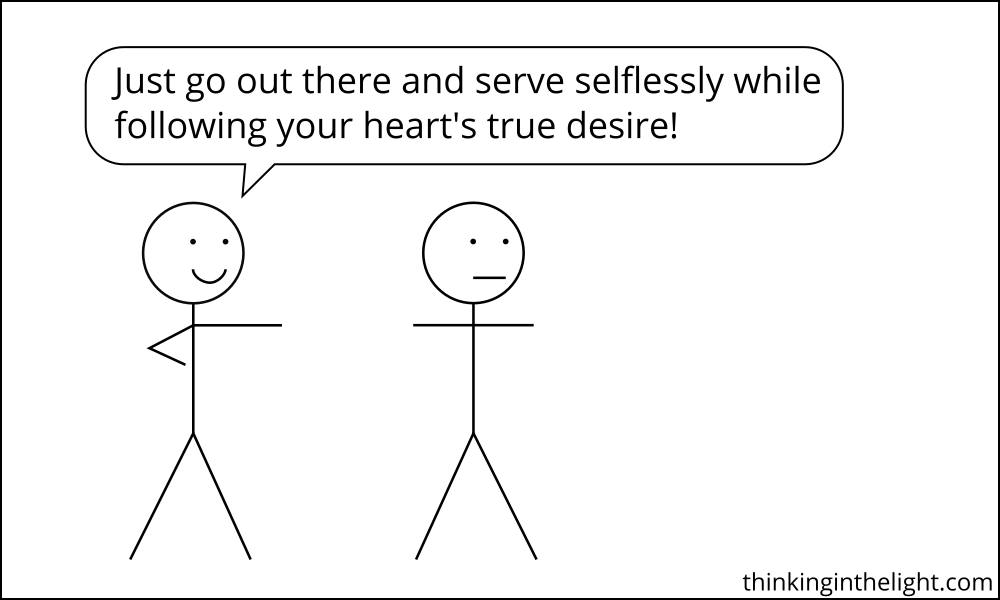
In this post I’m going to focus on Frozen as an example of this lack of clarity. (Spoiler alert for those who don’t want to know the plot, and “Let It Go” alert for those who don’t already have the song stuck in their head.) Frozen is worth examining, since it contains ambiguities as to what we should be listening to in life. My point in examining it here is not to say that the movie or the culture ought to take one side or the other—although I do think one is a better way to look at things. Rather, I want to illustrate the way our advice can be unclear, so that when discussing identity and the inner voice we can try to clarify the options instead.
Before moving on to the analysis, I must admit that despite its popularity I do not consider Frozen to be top-tier Disney. (I must also admit that forty-year-old men are probably not its target audience.) The animation is decent but has been surpassed by later improvements in computer graphics. The songs are catchy but feel slightly contrived. The story contains the worthwhile message that romantic love isn’t everything, but that message is delivered with a sledgehammer. Overall, I’d say the movie is solid but not amazing.
Frozen tells the story of two sisters, Anna and Elsa. In this post I will be focusing on Elsa, since her theme is identity. I will examine her story and see what sort of advice it might offer to the question “Should I look inside myself and act on that, or should I try to conform my actions to an external morality?”
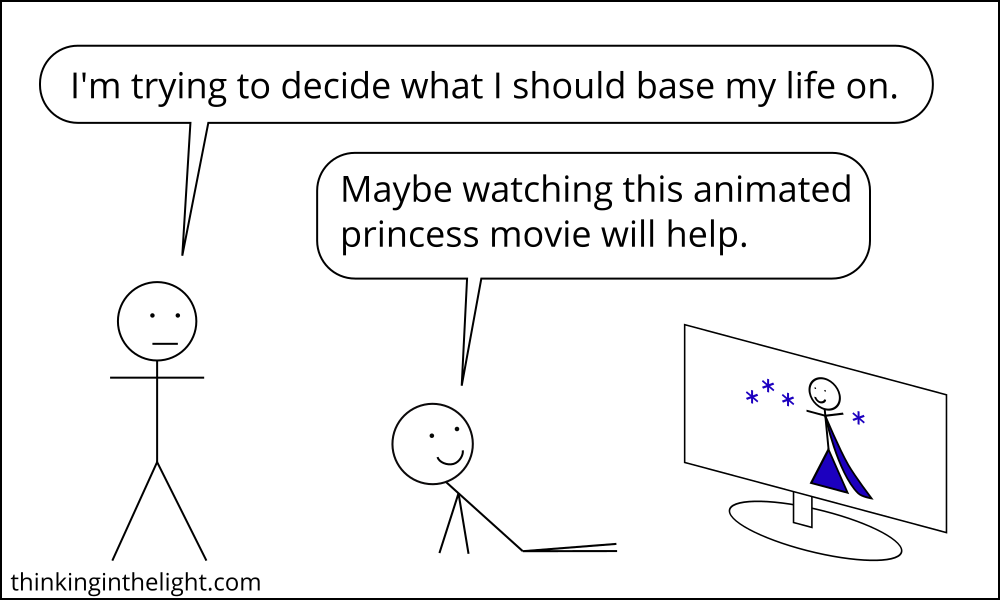
Elsa’s basic plot is quick to sketch. She has magical ice powers that she enjoys as a child. But the powers grow, and when she can’t control them she comes to fear the harm she may do to others and what people may think of her. So, despite the fact that she is queen-to-be, she shuts herself away in the castle and doesn’t let anyone know about her powers. At her coronation she accidentally reveals them and runs off. On her own, she lets it go and revels in her ice-castle-making skills while inadvertently freezing the whole kingdom. The bad guys come and capture her to make her unfreeze everything, but she can only do so once she learns, spurred on by her sister’s sacrificial example, to replace her fear with love. She becomes queen and the kingdom thrives. (Oh, and she brings to life a snowman with musical-theater skills, but I’ll leave that part out.)
Now that the basic plot is in view, let me tell the story in two different ways:
1) Elsa is comfortable with who she is but comes to fear it. She stops being herself and starts living with constraints in order to fit into society. By doing this she harms herself, her relationship to her sister, and eventually, when the constraints prove unworkable, the whole kingdom. In the end, by learning not to fear and to just be herself, she brings flourishing to everyone.
2) Elsa has a set of obligations, to her sister and to the kingdom, but she is not fulfilling them out of fear. When exposed, she turns inward, ignoring others and simply being herself. By doing this she harms everyone else. In the end, by learning to love others—turning towards them, rather than towards herself—and fulfilling her obligations as a result, she brings flourishing to everyone.
These are both plausible readings of the story, but they are in tension. In particular, is the solution for Elsa to look inside and be herself, or is that the problem? Frozen‘s ambiguous answer to this question is summed up in the hit song “Let It Go.” Elsa sings it right after she runs away, as she is freeing her hands from their gloves, her hair from its bun, and her ice powers from their hiding. In fact, in the song she is removing all external constraints, from the opinions of others to social norms.
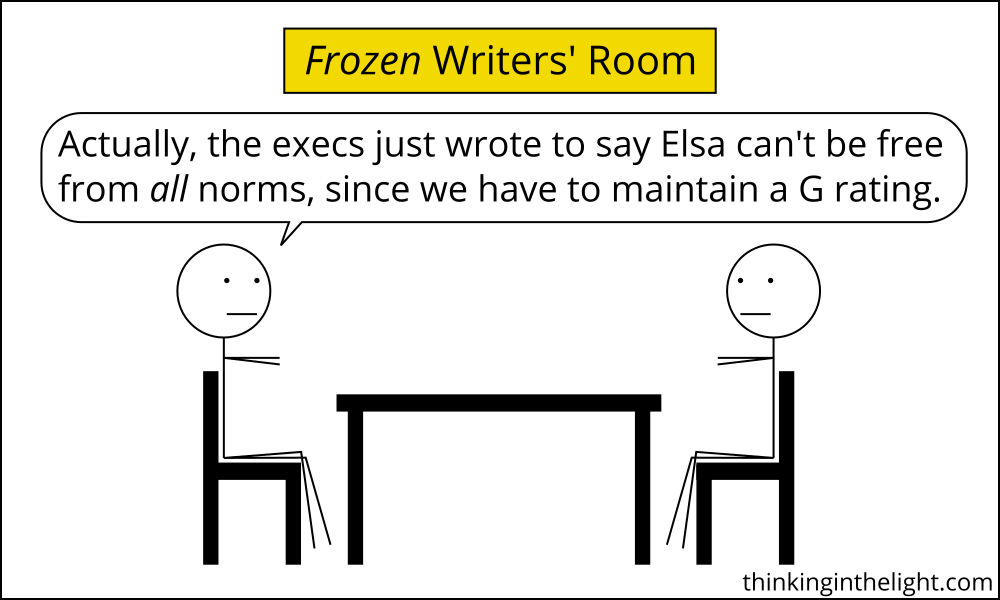
She starts by explaining the constraints she was under:
Don’t let them in, don’t let them see
Be the good girl you always have to be
Conceal, don’t feel, don’t let them know
But now things are different, and she is free of constraints:
Well now they know
Let it go, let it go
…
I don’t care what they’re going to say
Let the storm rage on
The cold never bothered me anyway
…
It’s time to see what I can do
To test the limits and break through
No right, no wrong, no rules for me
I’m free
This freedom, however, is the point at which the movie is most ambiguous. I am not sure to what extent this is a deliberate ambiguity (subtlety) or an unintentional one (lack of clarity), but in either case it is a point that we, as viewers, should disambiguate for ourselves.
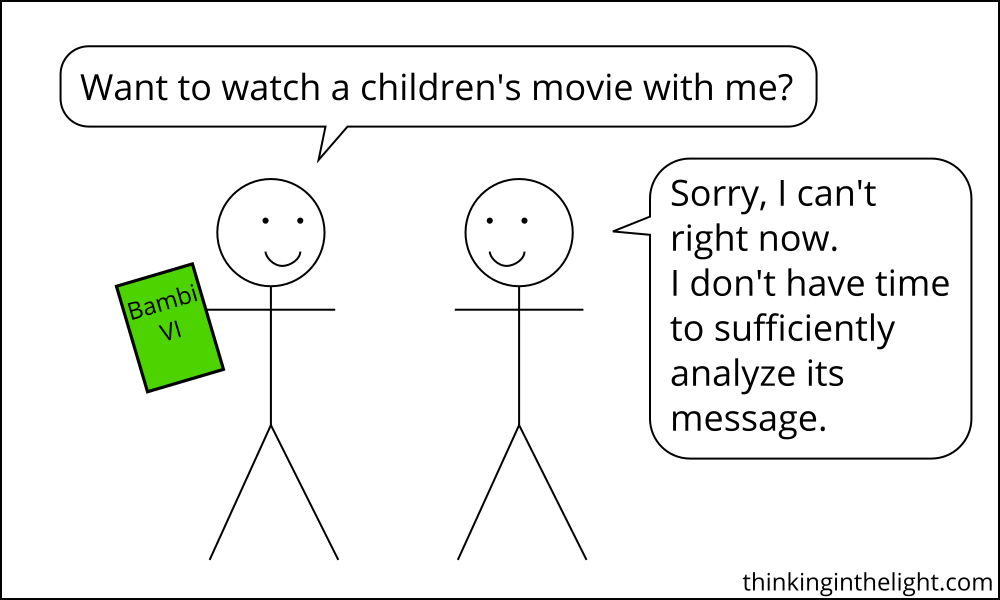
On the one hand, Frozen depicts this freedom as problematic. As seen in a later encounter with her sister, Anna, the freedom entails isolation:
I’m alone, but I’m alone and free
Just stay away and you’ll be safe from me
Elsa is being herself, but she recognizes the danger of this to others: “I belong here, alone, where I can be who I am without hurting anybody.” In response to this, Anna points out that even by isolating herself, Elsa has not succeeded in avoiding harm, since she has unknowingly plunged the whole kingdom into winter. At this news, Elsa starts despairing:
Oh I’m such a fool, I can’t be free
No escape from the storm inside of me
I can’t control the curse
Anna, please, you’ll only make it worse
There’s so much fear
You’re not safe here
And then Elsa accidentally freezes Anna’s heart, leading to her eventual death.
But at the same time that the movie shows the problems with Elsa letting out everything inside of her, it also depicts this freeing of herself in quite positive terms. “Let It Go” is a super catchy song that is clearly the high point of the movie musically. It is the part of Frozen that stuck with everyone (whether they wanted it to or not). Elsa even transforms visually during the song, letting down her bun into a long braid and exchanging her staid dress for a sexier one. And this is the Elsa that sold the Frozen merchandise by the boatload.
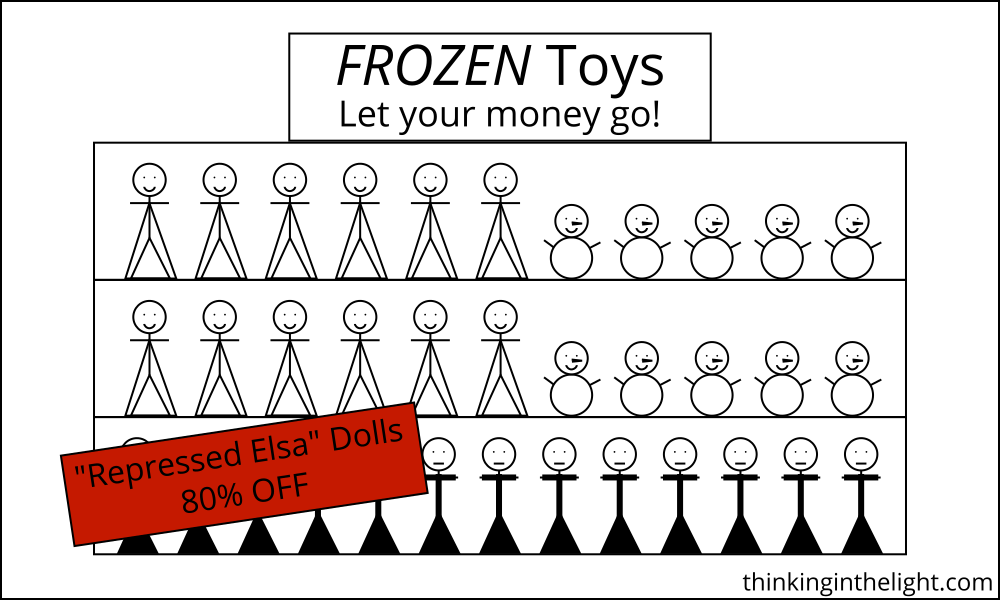
The song was sung by girls everywhere, given not only its catchiness but its anthemic, stirring lyrics:
Let it go, let it go
I am one with the wind and sky
Let it go, let it go
You’ll never see me cry
Here I stand and here I stay
…
Let it go, let it go
When I’ll rise like the break of dawn
Let it go, let it go
That perfect girl is gone
Here I stand in the light of day
It is important to notice this tension in how Frozen depicts Elsa’s turning away from what is external to her (rules and relationships) and towards what is inside—or as the movie presents it, Elsa’s becoming herself and actualizing her identity. As I noted in the post on Moana, sometimes being oneself by following the inner voice is presented as the way to help others. But if doing so is harming them instead, this raises the question of whether we should rather be looking outside ourselves to what the right thing to do is. (Which is more how Pinocchio depicts things.) Frozen acknowledges the harm done while simultaneously glamorizing the inward turn, leaving its advice to the viewer ambiguous. It is worth analyzing this ambiguity so that we can be clear about what the implications are of listening to an inner voice.
So what should Elsa do or how should Flo think about her future? In both cases I am inclined to say that they should think about what is right—and in particular, how their actions affect others—rather than look inwards. Their identity has less to do with their feelings and more to do with their responsibilities. Nevertheless, I could be wrong in my assessments, and I am open to being persuaded otherwise.
I will insist, however, that we present the issues clearly. It is not good to ignore any people that are being harmed, nor is it helpful to so glamorize a position such that its harms are obscured. In order to give unambiguous advice we must first clarify the options. It is important, when thinking about identity, to consider both exactly what the inner voice is that I might be listening to, as well as what sorts of external factors might appropriately define me.
In the next post I will look further at ways that the advice floating around in the culture can be ambiguous, including how this can affect the idea of a calling. To do so, I will remain with Elsa and journey into the sequel.
Share this post or sign up for future posts:
Bibliography:
- Frozen. Walt Disney Animation Studios, 2013. (Lyrics to Let It Go are copied from LyricFind.com, via Google search; lyrics from For the First Time in Forever (Reprise) are from disneyclips.com.)
